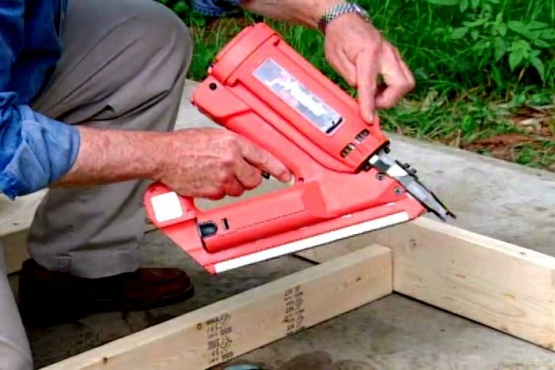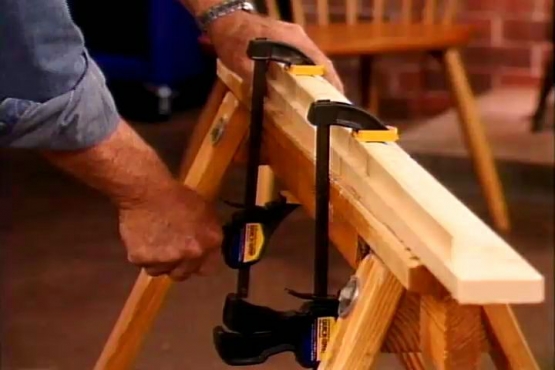RON HAZELTON:
Hey, thanks Dave! Now youngsters love to express themselves in all sorts of ways. Harper found expression with his stuffed toy menagerie. These children I'm about to visit love to draw, and their parents have come up with the intriguing idea of turning their play room into a kid-sized gallery for displaying their works of art.
[MUSIC/DOOR BELL]
Hey, Jinny!
JENNY:
Hey! Welcome!
RON HAZELTON:
How are you? Steve--
STEVE:
Nice to meet you.
RON HAZELTON:
So I understand we got a basement job, huh?
STEVE:
We do!
RON HAZELTON:
Let's take a look. So this is it - this is where the cork board's going to go.
JENNY:
This is it.
RON HAZELTON:
Now why do you want to put cork up?
JENNY:
Well, the kids entertain their friends down here, and we wanted them to be able to put things up on the walls - their posters and art works and make it their own place.
RON HAZELTON:
Without ruining your walls there?
JENNY:
Yeah, definitely.
RON HAZELTON:
[LAUGHS] Okay. Where are the kids right now?
JENNY:
They're upstairs, creating art works, I think.
RON HAZELTON:
Ah! Getting ready for his, huh?
JENNY:
Yep.
RON HAZELTON:
While the kids work on their creations for the soon to be art wall, mom, dad and I get started on the project.
Now this is the cork that we're actually going to put up on the wall. Now some people might just glue this right on to the wall, but I don't want to do that for two reasons. First of all, the push pins that we'll be using right here-- you see, they're so long, they go right through this cork material. That would leave you with a ton of small holes in the wall if you ever wanted to take this off.
But even worse, if we glue this on and try to remove it, it'll pretty much ruin the face of the wall board here. So we're going to use a different method to put this up.
Now the other thing that we're going to have to decide is where on the wall you actually want to put this. Now we could start it right down here at the base board, or we could raise it up anywhere here on the wall, wherever you would like it. What do you think? What looks good to you?
We begin by figuring out just how high we want the bottom edge of the cork border.
RON HAZELTON:
Higher?
JENNY:
Higher.
RON HAZELTON:
Higher?
JENNY:
Yeah, that looks good.
RON HAZELTON:
... about here - how does that look--
RON HAZELTON:
And settle on 30 inches. After measuring, we strike a chalk line across the wall. Our cork border will be put up in sections, or panels, that we'll attach directly to the wall studs. Now since we can't see the studs, Steve uses an electronic stud-finder to locate them.
Our final preparation step is to attach these strips or lumber, or ledgers as they're called, that will temporarily support the panels when we put them up later on.
Okay, guys--
The cork we'll be using is a quarter inch thick and comes in large rolls which we'll want to trim down to a more workable size.
What I want to do first of all is just do a, a rough cut on this--
Now this is eighth inch, untempered [bay snider ?] fiberboard. This is going to be a backing for the cork. We're going to glue the cork to this, using the contact cement. All right? So let's pour a little bit of this water-based non-flammable contact adhesive.
We'll pour some in a-- [POURING] paint tray here-- and we want to really soak the roller with this. Okay? Okay, Jenny why don't you come down here and start-- applying this to the cork.
JENNY:
Okay.
RON HAZELTON:
Steve if you begin up there.
Both the cork board and the masonite should be given a coat of contact cement. In fact, a second coat is recommended for the cork board, because the porous material tends to soak up the adhesive.
Okay, the contact cement is dry on both pieces. All right, now we can mate them together - but-- let's put this up first -this is called a slip sheet. I don't - we don't want these to stick until we've got 'em in exactly the right position--
JENNY:
Okay--
RON HAZELTON:
-- so that'll keep the-- two surfaces from touching each other. We're going to put the glue side down on the plastic-- all right -there we-- masonite with the cork on it--let's move it up here. Got it?
The cork is positioned on top of the masonite so that the edges are flush. The slip sheet is then carefully pulled from between the two panels while a roller is used to press the adhesive-covered surfaces into contact with each other.
To avoid bubbles, we roll from the center out toward the edges. We bond several more sheets of cork to the masonite backing boards. then it's time for installation.
Jenny measures the first section of wall. And Steve cuts a panel to fit.
[SAW WORKING]
Next, Jenny and Steve lift the panel into position and set the bottom on the temporary ledger we installed earlier.
The ledger supports the panel while we begin attaching it to the wall studs with screws. A piece of string with a weight on the end is lined up with the marks we made earlier, showing the location of the wall studs. It makes a great guide telling us exactly where to place the screws.
Loose edges next to the door frame are
[MUSIC]
easily secured with pneumatic nail gun. A rotary saw used to make [SAW WORKING] openings in wall board quickly makes a cutout for the light switch.
Now the pace quickens as we place one panel after another into position.
[SCREW GUN]
With the panels up, we can now take the temporary ledger down.
[BACKGROUND CONVERSATION]
RON HAZELTON:
Okay, well we've got all this up. You guys did a great job!
JENNY:
Wow, it's looking great!
RON HAZELTON:
It looks very nice, but I want to do two things. I'm going to put up some trim right along the edges here to sort of hold the edges down and also to conceal them, and then some more trim here to cover these screws and these seams right here.
So let's cut that and start putting it up, all right?
STEVE:
Okay.
[MACHINERY]
RON HAZELTON:
Okay. If you'll just put that--
[MUSIC]
yeah, that's great. That way we make sure we've got a nice fit in the corner there; we're not going too far. Okay, now we're going to nail right into the stud here-- so it's going to hold this.
[NAIL GUN]
[BACKGROUND CONVERSATION]
RON HAZELTON:
After adding the trim molding, our cork border really starts to take shape.
[NAIL GUN]
RON HAZELTON:
Well, we did it.
JENNY:
We sure did.
STEVE:
[...?...] nice.
RON HAZELTON:
I kind of like this.
WOSTEVE:
I think it looks great!
RON HAZELTON:
And the best thing about it is if your plans change or your tastes change-- you can have this out of here in an hour. Really - a little spackle and [...?...].
STEVE:
It's great the way you did it.
RON HAZELTON:
I'm going to head down the road-- thank you so much - you guys were great to work with.
STEVE:
Thank you so much.
RON HAZELTON:
Well I'd hardly gotten out the door when the kids went to work decorating their new wall, creating a style all their own.
STEVE:
All right! We got it on!








